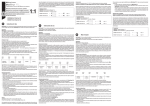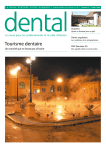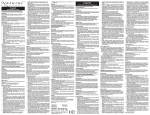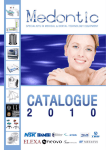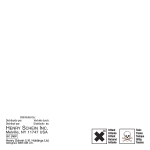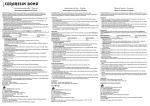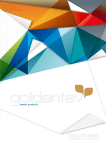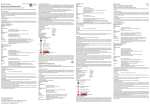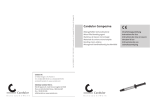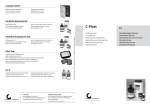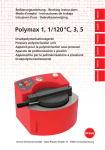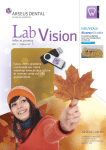Download Gebruiksaanwijzing
Transcript
Candulor Zähne Lebende Zahnformenkarte Carte de formes vivante Carta de formas en vivo Levende tandformkort Aesthetic Working mould chart Tabella forme in-vivo Levende Vormenkaart Intensive Colors Intensivfarben Pigments de couleurs intensives Colores intensivos Intensivfarver AutoPlast Intensive colour pigments Colori Intensivi Intensieve kleuren Kaltpolymerisat Cold curing denture base material Résine de base autopolymérisante Resina polimerizzante a freddo Resina autopolimerizable Koudpolymerisaat Ultra Tray Lichthärtendes Löffelmaterial Light curing tray material Résine photopolymérisante pour porte-empreintes individuels Resina fotoindurente per porta-impronte individuali Material fotopolimerizable para cubetas individuales Lichtuithardend lepelmateriaal Lyshærdende skemateriale Löffelmaterial Résine pour porte-empreintes Lepelmateriaal Skemateriale Tray material Resina per porta-impronte Material para cubetas Iso-K Isolierflüssigkeit für alle Kunststoffe Separating liquid for all types of acrylic Liquide isolant toutes résines Liquido isolante per tutte le resine Separador para todo tipo de resinas Isolatievloeistof voor alle kunstharsen Isoleringsvæske for alle plasttyper K u n s t Z a h n W e r k Candulor AG CH-8602 Wangen/ZH, Pünten 4, Postfach 89 Tel. +41 (0)44 805 90 00, Fax +41 (0)44 805 90 90 www.candulor.com, [email protected] Art.-Nr. 9030 0060 12/2010 4000 REV02 www.teama5.com © Copyright 2010 Candulor AG, Wangen/ZH C-Plast K u n s t Z a h n W e r k 0120 Verarbeitungsanleitung Instructions for Use Instructions de mise en oeuvre Istruzioni d’uso Gebruiksaanwijzing Instrucciones de uso Deutsch AutoPlast Gefahrenhinweise AutoPlast ist ein kaltpolymerisierendes Prothesenmaterial auf PMMA-Basis für die Giesstechnik. Das Material zeichnet sich durch besonders gute Fliess- und Modelliereigenschaften aus. Um ein optimales Ergebnis erzielen zu können, lesen Sie bitte diese Verarbeitungsanleitung. • Monomer enthält Methylmethacrylat (MMA) • MMA ist reizend und leicht entzündlich (Flammpunkt: + 10 °C) • MMA und dessen Dämpfe reizt Augen, Atmungsorgane und Haut • Sensibilisierung durch Hautkontakt ist möglich • Dämpfe nicht einatmen • Von Zündquellen fernhalten – Nicht rauchen • Nicht in die Kanalisation gelangen lassen • Hautkontakt mit Monomer und unausgehärtetem Material vermeiden. Viele gebräuchliche Handschuhe, zum Beispiel aus Latex oder Vinyl, sind nicht gegen Monomer beständig und schützen aus diesem Grund nicht wirksam vor Sensibilisierung gegenüber Methacrylaten. • Zum Beschleifen Mundschutz tragen und Absauganlage benutzen. • Mischungen nur mit Spatel bearbeiten. • Massnahmen gegen elektrostatische Aufladungen treffen. Zusammensetzung Warnhinweis Kaltpolymerisat Einleitung Sehr geehrter Kunde Sie halten ein Medizinprodukt gemäss der RL 93/42/EWG in Ihren Händen. Bitte hinterlegen Sie in Ihrer Administration sofort nach Eingang des Produktes die LOT-Nummer und den dazugehörigen Produktenamen. Notieren Sie für jede hergestellte Arbeit, alle verwendeten Materialien mit allen LOT-Nummern. Zum Schutz von Ihnen, Ihren Patienten und unserer Umwelt beachten Sie des weiteren auch die wichtigen Hinweise in dieser Verarbeitungsanleitung. Produktbeschreibung Pulver Polymethylmethacrylat, Katalysator, Pigmente Flüssigkeit Methylmethacrylat stab., Dimethacrylat, Katalysator, Stabilisator Lagerungshinweise Material an einem dunklen, kühlen und gut belüfteten Ort aufbewahren. Lagertemperatur 12–28 °C. Produkte nach Ablauf des Verfalldatums nicht mehr verwenden. Für Kinder unzugänglich aufbewahren. Indikation • Totalprothetik • Teilprothetik • Kombinationsprothetik • Unterfütterungen • Reparaturen Kontraindikation Direkten Kontakt von unpolymerisiertem Material im intraoralen Bereich vermeiden. Bei erwiesener Allergie auf Bestandteile von Aesthetic Autopolymerisat auf die Anwendung verzichten. Nebenwirkungen Systematische Nebenwirkungen sind bisher keine bekannt. In Einzelfällen wurden bei Prothesenbasismaterialien auf PMMA/MMA-Basis lokale allergische Reaktionen beschrieben. Bei erwiesener Allergie auf Bestandteile von AutoPlast auf die Anwendung verzichten. Das Kunststoffmaterial wurde für den Einsatz im Dentalbereich entwickelt. Die Verarbeitung erfolgt analog der Verarbeitungsanleitung. Für Schäden, die sich aus der Nichtbeachtung der Verarbeitungsvorschriften und des Einsatzgebietes ergeben, wird keine Haftung übernommen. Dies gilt auch, wenn das Produkt mit Produkten von Mitbewerbern gemischt oder zusammen verarbeitet wird. Darüber hinaus ist der Verwender verpflichtet, das Material eigenverantwortlich vor dessen Einsatz auf Eignung und Verwendungsmöglichkeit für die vorgesehenen Zwecke zu prüfen, zumal wenn diese Zwecke nicht in der Verarbeitungsanleitung aufgeführt sind. Sicherheitsdatenblätter finden Sie auf unserer Homepage unter www.candulor.com Deutsch Verarbeitungsanleitung 1. Vorbereiten Ausgebrühte, gut gewässerte Gipsflächen zweimal mit Candulor Iso-K isolieren und gut trocknen lassen. Für einen guten Verbund zur Prothesenbasis die Zähne gut anrauen und mit mechanischen Retentionen versehen. Anschliessend mit Monomer benetzen. 2. Dosierung Ideales Mischverhältnis: 13 g Polymer : 10 ml Monomer PolyMaster: 26 g Polymer : 20 ml Monomer Dosiersystem Das integrierte Dosiersystem ergibt ein ideales Mischungsverhältnis und die geringste Polymerisationsschrumpfung von Autoplast Kaltpolymerisat. Die Markierung am Polymerbecher weist eine GrammSkala auf. Die Markierung am Monomerzylinder weist eine Milliliter-Skala auf. Bei zu hohem Monomergehalt verändern sich Farbe, Konsistenz und Handhabung. Zusätzlich wird die Polymerisation beeinträchtigt. Dies kann zu Schleimhautreizungen und Porosität führen. 3. Anmischen Pulver und Flüssigkeit im angegebenem Mischverhältnis mit dem Spatel ca. 20 Sek. anrühren und gut durchmischen. Anschliessend 15 Sekunden stehen lassen, damit eventuelle Blasen aufsteigen können. Pulver und Flüssigkeit intensiv mischen. Eine höhere Raumtemperatur verkürzt die Verarbeitungsund die Abbindezeit. 4. Fliessphase Die Fliessphase beträgt ca. 2.5–3 Minuten bei Raumtemperatur (18–25 °C). In dieser Zeit das Material in den Sattel einfliessen lassen. 5. Modellierphase Nach einer Übergangsphase von ca. 5–6 Minuten ist das Material standfest und während weiteren 3 Minuten modellierfähig. Der Kunststoff muss spätestens nach 10–11 Minuten in den Drucktopf gegeben werden. 6. Polymerisation Die Polymerisation erfolgt im Drucktopf während 15 Minuten bei 40 °C und 2 bar Druck. Polymerisationszeit einhalten. Mit dem idealen Mischungsverhältnis und der empfohlenen Methode wird ein Restmonomergehalt von < 4.5 % erreicht. Schnelles Abkühlen in kaltem Wasser vermeiden (Spannungsrisse)! 7. Ausarbeiten Den Vorguss entfernen. Okklusionskontrolle bei den Prothesen durchführen, und in gewohnter Weise ausarbeiten. Nach dem Vor- und Hochglanzpolieren mit Candulor KMG Poliermittel abspülen. Reparatur- und Korrekturmöglichkeit von AutoPlast Reparaturen und Korrekturen können mit AutoPlast selber oder Aesthetic Autopolymerisat durchgeführt werden. Dabei die entsprechenden Verbindungsstellen mit einer Fräse gut anrauen und mit Monomer benetzen. Anschliessend angemischtes Material auftragen und nach der entsprechenden Polymerisationsbeschreibung polymerisieren. English AutoPlast cold curing acrylic denture base material Introduction The product that you have purchased qualifies as a medical device under European Directive 93/42/EEC. Please ensure that you file the lot number and product name in your administrative system on receipt of the product. For each piece of work that you produce, please make a note of all the materials used along with all the appropriate lot numbers. For your own protection as well as for the protection of your patients and the environment, please also follow the important guidelines in the following Instructions for Use: Product Description AutoPlast denture base is a cold-curing, PMMA-based acrylic for the pouring technique. It has excellent flow and modelling properties which make it easy to use. To achieve the best results, please follow the instructions given in this leaflet. Composition Powder Polymethyl methacrylate, catalyst, pigments Liquid Methyl methacrylate stab., dimethacrylate, catalyst, stabilizer Storage instructions Store the material in a cool, dark, well-ventilated place. Storage temperature: 12–28 °C / 54–82 °F. Do not use the material after the expiry date. Keep out of the reach of children. Indication • Full dentures • Partial dentures • Combination dentures • Relining • Repairs Contraindication Avoid direct contact with unpolymerised material within the oral cavity. If a patient is known to be allergic to any of the ingredients in Aesthetic Autopolymerisat, the material must not be used. Side effects No systemic side effects have been reported to date. In individual cases, local allergic reactions to PMMA/ MMA-based denture base materials have been reported. If a patient is known to be allergic to any of the ingredients in AutoPlast, the material must not be used. English Danger warnings • The monomer contains methyl methacrylate (MMA) • MMA is an irritant and easily flammable (flash point: + 10 °C / 50 °F) • MMA and its vapours are irritating to the eyes, skin and respiratory system • May cause sensitisation upon skin contact • Do not inhale vapours • Keep away from sources of ignition – no smoking • Do not empty into drains • Avoid contact of the skin with monomer and uncured material. Many commercial gloves, e.g. those made of latex or vinyl, are not monomer-resistant and therefore do not provide protection against the sensitising effect of methacrylates • Wear a mask when grinding and use a suction removal system • Always use a spatula when handling the mixture • Take precautionary measures against static discharges. Warning This material has been developed solely for use in dentistry and must be handled strictly in accordance with the Instructions for Use. The manufacturer cannot be held liable for any damages arising as a result of failure to observe the Instructions for Use or the stated area of application. The same applies in the event that the product is mixed or processed with other manufacturers’ products. The user shall be solely responsible for testing the material with respect to its suitability prior to use for any purpose other than those explicitly stated in the instructions. CAUTION: US Federal law restricts this device to sale by or on the order of a licensed dentist. Safety data sheets can be found on our website at www.candulor.com Instructions for Use 1. Preparation After boiling out the water-saturated plaster, isolate the surfaces with two applications of Candulor ISO-K separating liquid and allow to dry thoroughly. To ensure proper bonding with the denture base, roughen the teeth well and fit retentions, then wet with monomer. 2. Dosage Ideal mixing ratio: 13 g polymer : 10 ml monomer PolyMaster: 26 g polymer : 20 ml monomer Variable dosage within normal limits The integrated dosage system ensures an ideal mixing ratio and minimum polymerisation shrinkage of AutoPlast. The scale on the monomer cylinder is in millilitres, on the polymer beaker in grams. Too high a monomer content will alter the shade, consistency and handling properties of the material. This may also inhibit polymerisation, possibly leading to irritation of the mucous membranes and to porosity. 3. Mixing Mix together the powder and liquid, based on the recommended ratio, for approx. 20 seconds using the spatula. Blend thoroughly. Leave to stand for 15 seconds so that any air bubbles can escape. Mix the powder and liquid thoroughly. 4. Pouring phase The higher the room temperature, the shorter the pouring and setting phases. The pouring phase lasts approximately 2.5–3 minutes at room temperature (18 °C – 25 °C; 64 °F – 77 °F). Pour the material into the mould within this time span. 5. Modelling phase After a transition phase of roughly 5–6 minutes the material will assume a firmer consistency and can be modelled for a period of 3 minutes. 6. Polymerisation Polymerisation in the pressure vessel takes 15 minutes at a temperature of 40 °C and a pressure of 2 bar. The stated polymerisation times must be observed. If the ideal mixing ratio and the recommended methods are used, a residual monomer content of < 4.5 % can be achieved. 7. Finishing Remove the precast. Check the occlusion of the denture and finish in the usual manner. Rinse with Candulor KMG after the preliminary and high-gloss polishes. Repair and correction of AutoPlast cold curing acrylic Repairs or corrections may be carried out using either AutoPlast itself or Aesthetic cold curing material. The contact surfaces must be well roughened and wetted with monomer. Then apply the mixed material and polymerise as described in the instructions. French AutoPlast French Consignes de sécurité AutoPlast est une résine polymérisante à froid et à base de PMMA, pour la confection de prothèses par coulée. Elle se distingue par de très bonnes caractéristiques de fluidité et de modelage. Afin d‘obtenir un résultat optimal, veuillez lire attentivement le présent mode d‘emploi. • Les monomères contiennent du méthacrylate de méthyle (MMA) • Le MMA est irritant et s’enflamme facilement (point d‘inflammation + 10 °C) • Les vapeurs du MMA provoquent des irritations des yeux, des voies respiratoires et de la peau • Peut entraîner une sensibilisation par contact cutané • N‘inhalez pas les fumées • Conservez à l‘écart de toute source d‘ignition – ne pas fumer! • Ne déversez pas le produit dans les canalisations • Evitez tout contact cutané avec le monomère et le matériel non polymérisé. De nombreux gants usuels, par exemple en latex ou en vinyle, ne résistent pas au monomère et n’offrent dès lors aucune protection appropriée contre la sensibilisation aux méthacrylates • Pour le polissage, il convient de porter une protection buccale et d’utiliser une installation d’aspiration • Travailler les mélanges uniquement au moyen d’une spatule. • Prendre des mesures contre les charges électrostatique. Composition Avertissement Résine polymérisable à froid Introduction Chère cliente, cher client, Vous tenez dans vos mains un produit médical conforme à la directive RL 93/42/CEE. Lors de la réception du produit, veuillez encoder immédiatement le numéro du LOT et le nom du produit correspondant dans votre administration. Pour chaque travail réalisé, notez tous les matériaux utilisés ainsi que l’ensemble des numéros de LOT. En outre, pour votre protection et pour celle de vos patients, respectez également les consignes importantes contenues dans le mode d’emploi ci-dessous. Description du produit Poudre Polyméthacrylate de méthyle, catalyseur, pigments Liquide Méthacrylate de méthyle, diméthacrylate, catalyseur, stabilisateur Consignes de stockageet de conservation Conservez le produit dans un endroit frais, sombre et bien aéré. Température ambiante admissible entre 12 et 28 °C. Ne plus utiliser le produit après la date de péremption. Conservez le produit à l‘abri des enfants. Indications • Prothèses totales • Prothèses partielles • Prothèses combinées • Rebasages • Réparations Cette résine a été conçue pour une utilisation dans le domaine dentaire. La mise en oeuvre doit se faire conformément au mode d‘emploi. Le fabricant décline toute responsabilité pour des dommages résultant du non-respect des consignes de mise en oeuvre ou du champ d‘application. Il en va de même lorsque le produit est mélangé ou utilisé conjointement à d‘autres produits proposés par des entreprises concurrentes. En outre, l‘utilisateur est tenu, avant toute utilisation, de contrôler sous sa propre responsabilité, l‘adéquation du produit par rapport au but visé, d‘autant plus lorsque le but en question ne figure pas dans les consignes de mise en oeuvre. Pour les fiches de données sécurité CE, consultez notre site Internet www.candulor.com Consignes de mise en œuvre 1. Préparation Appliquez deux couches de liquide isolant Candulor ISO-K sur le modèle ébouillanté et bien humidifié. Laissez sécher suffisamment longtemps. Afin d’assurer une bonne liaison avec le matériau pour prothèse, il convient de bien poncer les dents et de les doter de rétentions mécaniques. Appliquez ensuite le monomère. 2. Dosage Proportions idéales : 13 g de polymère pour 10 ml de monomère PolyMaster: 26 g polymère pour 20 ml de monomère Système de Dosage L‘utilisation du système de dosage intégré garantit les proportions de dosage idéales et un retrait limité de la polymérisation de la Résine AutoPlast. Le marquage sur le cylindre de mesure du polymère est exprimé en grammes. Le marquage sur le cylindre de mesure du monomère est exprimé en millimètres. Si la teneur en monomère est trop importante, la teinte, la consistance et la manipulation varient. En outre, cela affecte la polymérisation et peut provoquer des irritations des muqueuses et de la porosité. 3. Mélange Mélangez la poudre et le liquide pendant environ 20 sec. en fonction des proportions indiquées. Utilisez une spatule et mélangez vigoureusement. Laissez reposer le mélange pendant environ 15 secondes afin de permettre aux bulles éventuelles de remonter. La poudre et le liquide doivent être mélangés vigoureusement. Une température ambiante plus élevée diminuera d‘autant le temps de mise en oeuvre/de prise. 4. Phase fluide La phase fluide dure environ 2.5 à 3 minutes à une température ambiante de 18–25 °C. Verser la résine dans les selles pendant cette phase. Contre-indications 5. Phase de modelage Effets secondaires 6. Polymérisation Evitez tout contact direct de matériaux non polymérisés au niveau interoral. En cas d‘allergie attestée à l‘un des composants de la Résine Autopolymerisante Aesthetic, il est préférable de renoncer à l‘emploi de ce produit. Aucun effet secondaire systémique n‘est connu à ce jour. Dans certains cas isolés, des réactions locales allergiques aux matériaux à base de PMMA/MMA ont été observées. En cas d‘allergie attestée à l‘un des composants de la résine AutoPlast, il est préférable de renoncer à l‘emploi de ce produit. Après une phase intermédiaire de 5 à 6 minutes environ, la résine devient consistante. Il vous reste alors 3 minutes pour la modeler. La matière synthétique doit être placée dans l‘autoclave au plus tard après 10–11 minutes. La polymérisation doit avoir lieu sous pression dans un polymérisateur pendant 15 minutes, à une température de 40 °C et à une pression de 2 bars. Respectez le temps de polymérisation prescrit! Grâce au rapport de mélange idéal et à la méthode recommandée, on obtient une teneur en monomère résiduel de < 4.5 %. Evitez le refroidissement rapide dans de l‘eau froide. (Fissure de contrainte). 7. Finition Enlever la clé. Effectuez le contrôle d’occlusion des prothèses et terminez-les de façon habituelle. Après le polissage préliminaire et haut brillant, rincez avec du Candulor KMG. Possibilités de réparation et decorrection de l‘Auto Plast Les corrections et réparations peuvent être réalisées avec l’AutoPlast même ou avec la Résine Autopolymérisante Aesthetic. A cet effet, poncez soigneusement les surfaces de collage à l’aide d’une fraise et enduisez-les de monomère. Appliquez ensuite la résine préalablement malaxée puis polymérisez comme indiqué. Italian AutoPlast Polimerizzante a freddo Introduzione Egregio Cliente Ha ricevuto un dispositivo medico secondo la direttiva 93/42/CEE. All’entrata del prodotto, La preghiamo di depositare presso la Sua amministrazione il numero LOT ed il corrispondente nome del prodotto. Per ogni lavoro realizzato, annoti tutti i materiali impiegati con tutti i numero LOT. A tutela Sua, del paziente e dell’ambiente, si attenga inoltre alle seguenti importanti avvertenze contenute nella presente istruzione d’uso. Descrizione prodotto AutoPlast è una resina per protesi a base di PMMA, di semplice utilizzo e polimerizzante a freddo per la tecnica di colaggio. Il materiale si distingue per le sue ottime caratteristiche di colaggio e modellabilità. Per ottenere un risultato ottimale, si prega di leggere attentamente le presenti istruzioni d‘uso. Composizione Polimero polimetilmetacrilato, catalizzatore, pigmenti Monomero metilmetacrilato stab., dimetacrilato, stabilizzatori Avvertenze per la conservazione Conservare il materiale in luogo scuro, fresco e ben arieggiato. Temperatura di conservazione 12–28 °C. Non utilizzare più il prodotto dopo la data di scadenza. Conservare fuori dalla portata dei bambini. Indicazioni • Protesi totali • Protesi parziali • Protesi combinate • Ribasature • Riparazioni Controindicazioni Evitare assolutamente il contatto diretto di materiale non polimerizzato in zona intraorale. In caso di allergia dimostrata a componenti di Aesthetic Autopolymerisat, evitarne l’uso. Effetti collaterali Non sono finora noti effetti collaterali di tipo sistemico. In singoli casi sono state descritte reazioni locali allergiche a materiali per protesi a base di polimetilmetacrilato/ metilmetacrilato. In caso di allergia dimostrata a componenti di AutoPlast, evitarne l’uso. Italian Avvertenze di pericolo • Il monomero contiene metilmetacrilato (MMA) • MMA è facilmente infiammabile (punto d‘infiammabilità + 10 °C) • MMA ed i suoi vapori sono irritanti per gli occhi, gli organi respiratori e la cute • E‘ possibile una sensibilizzazione in seguito a contatto cutaneo • Non inalare i vapori • Tenere lontano da fonti infiammabili – Non fumare • Non lasciare defluire nella canalizzazione idrica • Evitare il contatto cutaneo con monomero e materiale non indurito. Molti dei guanti in commercio, p.e. in lattice o vinile, non sono resistenti al monomero e pertanto non offrono una protezione efficace dalla sensibilizzazione ai metacrilati. • Durante la rifinitura usare mascherina ed impianto di aspirazione. • Lavorare l’impasto soltanto con spatola. • Prendere provedimenti contro cariche elettrostatiche. Avvertenza Il materiale è stato sviluppato per l’impiego nel campo dentale. La lavorazione avviene secondo le istruzioni d’uso. Per danni derivanti dalla mancata osservanza delle prescrizioni contenute nelle istruzioni d‘uso, non ci si assume alcuna responsabilità. Questo vale anche se il prodotto viene miscelato o lavorato insieme a prodotti di altri produttori. Inoltre l‘utilizzatore, prima dell‘utilizzo, è tenuto a controllare l‘idoneità e le possibilità di impiego del materiale per gli scopi da lui previsti, in particolare, se questi scopi non sono riportati nelle istruzioni d‘uso. Troverete la scheda di sicurezza sulla nostra homepage www.candulor.com Istruzioni d‘uso 1. Preparazione Isolare per due volte con Candulor ISO-K le superfici deterse e ben bagnate e lasciare asciugare correttamente. Per una buona adesione con la base della protesi irruvidire accuratamente i denti e realizzare ritenzioni meccaniche. Quindi umettare con monomero. 2. Dosaggio Rapporto ideale di miscelazione: 13 g polimero : 10 ml monomero PolyMaster: 26 g polimero : 20 ml monomero Dosaggio libero L‘impiego del sistema di dosaggio, grazie ai misurini integrati nella confezione, garantisce un rapporto di miscelazione ideale ed una minima contrazione da polimerizzazione di AutoPlast. Sul misurino per il polimero sono riportate le demarcazioni in grammi. Sul misurino per monomero è riportata una scala millilitrica. In caso di eccessivo contenuto di monomero si possono verificare variazioni di colore, consistenza e i lavorazione. Inoltre viene influenzata anche la polimerizzazione. Ciò può causare irritazioni della mucosa e porosità. 3. Miscelazione Miscelare accuratamente la polvere ed il liquido nel suo ideale rapporto con una spatola per 20 sec. Lasciare riposare per 15 sec. affinchè eventuali bolle possano risalire in superficie. Miscelare intensamente polvere e liquido. Una temperatura ambiente più elevata abbrevia il tempo di lavorazione ed il tempo di presa. 4. Fase di colaggio La fase di colaggio è di ca. 2.5–3 min. a temperatura ambiente (18–25 °C). Colare il materiale nella sella durante questo tempo. 5. Fase di modellazione Dopo una fase intermedia di ca. 5–6 min. il materiale è stabile e modellabile per ulteriori 3 min. Il materiale deve essere posizionato in pentola a pressione al più tardi dopo 10–11 min. 6. Polimerizzazione La polimerizzazione avviene in pentola per 15 min. a 40 °C e 2 bar di pressione. Attenersi al tempo di polimerizzazione. Con il rapporto di miscelazione ideale ed il metodo consigliato si ottiene un contenuto di monomero residuo: < 4.5 %. Evitare un raffreddamento rapido in acqua (incrinature da tensione). 7. Rifinitura Rimuovere la mascherina. Effettuare il controllo occlusale della protesi e rifinire come di consueto. Dopo la prelucidatura e lucidatura a specchio con Candulor KMG, sciacquare. Possibilità di riparazioni e correzioni di AutoPlast E‘ possibile eseguire riparazioni o correzioni con AutoPlast stesso o con l’autopolimerizzante Aesthetic. Irruvidire accuratamente con una fresa le zone da congiungere ed umettare con monomero. Infine applicare il materiale miscelato e polimerizzare secondo le relative indicazioni. Español AutoPlast Polimerización en frío Introducción Estimado cliente Tiene en sus manos un producto sanitario según RL 93/42/EWG. Introduzca en su ficha, inmediatamente después de la compra, el número de lote y el nombre del producto. Para cada trabajo realizado, anote los materiales utilizados con los números de lote. Para su seguridad, la de los pacientes y para el medio ambiente tenga en cuenta las indicaciones que figuran en estas instrucciones de uso. Descripción del producto AutoPlast es un material de prótesis autopolimerizable en base a PMMA para la técnica de vertido. El material destaca por su cómoda manipulación y su capacidad de fluido. Para obtener resultados óptimos, lea atentamente las siguientes instrucciones e uso. Composición Polvo Polimetilmetacrilato, catalizador, pigmentos Líquido Metilmetacrilato estab., dimetacrilato, catalizador, estabilizador Indicaciones sobre almacenamiento Conservar el material en lugar oscuro, fresco y bien ventilado. Temperatura de almacenamiento: 12–28 °C. No utilizar una vez caducado. Mantener alejado de los niños. Indicación • Prótesis total • Prótesis parcial • Prótesis combinada • Rebases • Composturas Contraindicación Evitar el contacto de material sin polimerizar con la cavidad oral. En caso de alergia conocida a alguno de los componentes de Aesthetic Autopolymerisat, no utilizar. Efectos secundarios Hasta la fecha no se han descrito efectos secundarios sistémicos En casos aislados se han descrito alergias localizadas a los materiales de prótesis en base a PMMA/MMA. En caso de alergia conocida a alguno de los componentes de AutoPlast, no utilizar. Español Indicaciones de riesgos • El monómero contiene metilmetacrilato (MMA) • MMA irrita y es ligeramente inflamable (punto de combustión + 10 °C) • MMA y sus vapores irritan los ojos, las vías respiratorias y la piel • Sensibilización por contacto con la piel • No inhalar los vapores • Mantener alejado de fuentes de calor – No fumar • No verter por el desagüe • Evitar el contacto prolongado o repetido de la piel con el monómero y material sin polimerizar. Muchos de los guantes disponibles en el mercado, como por ejemplo los de látex o de vinilo no son resistentes al monómero, por lo que no protegen de forma eficaz frente a la sensibilización a los metacrilatos • Utilizar mascarilla e instalación de aspiración durante el repasado • Realizar la mezcla solo con espátula • Adaptar medidas contra largas electrostáticas. Advertencias El material ha sido desarrollado para su uso dental y debe manipularse según las instrucciones de uso. El fabricante no se hace responsable de los daños ocasionados por otros usos o aplicaciones no descritas en las instrucciones de uso. Ello también aplica en caso de mezclar o manipular con productos de la competencia. Además, el usuario está obligado a comprobar, bajo su propia responsabilidad, antes de su uso, si el material es apto para los fines previstos, sobre todo si estos no figuran en las instrucciones de uso. En nuestra página web www.candulor.com encontrará las hojas de datos de Seguridad. Instrucciones de uso 1. Preparación Aplicar dos capas de separador Iso-K Candulor sobre los modelos de yeso escaldados y bien embebidos en agua. Dejar secar bien. Para asegurar la unión con el material de prótesis, crear retenciones en los dientes con una fresa y humectar con monómero. 2. Dosificación Proporción de mezcla ideal: 13 g de polímero : 10 ml de monómero PolyMaster: 26 g de polimero : 20 ml de monomero Sistema de dosificación: La utilización del sistema de dosificación que incluye el envase garantiza una proporción de mezcla ideal y una mínima contracción de polimerización de AutoPlast. El vaso de dosificación de polímero lleva una escala en gramos. El vaso de monómero tiene una escala milimetrada. Con un contenido excesivamente elevado de monómero se modifica el color, la manipulación y la contracción. Además, influye en la polimerización. Ello podría irritar la mucosa bucal. 3. Mezcla Con una espátula, mezclar bien el polvo y el líquido en la proporción de mezcla indicada durante unos 20 seg. Dejar reposar la mezcla durante unos 15 segundos para que puedan ascender a la superficie posibles burbujas. Mezclar bien el polvo y el líquido. Una temperatura ambiente elevada reduce el tiempo de manipulación y de polimerización 4. Fase de fluido La fase de fluido duras unos 2.5–3 minutos a temperatura ambiente (18–25 °C). Durante este tiempo se vierte el material sobre el modelo. 5. Fase de modelado Tras una fase de transición de unos 5–6 minutos, el material es estable y está preparado para modelar durante otros 3 minutos. El material debe introducirse como máximo en 10–11 minutos en el aparato de presión. 6. Polimerización La polimerización se lleva a cabo en máquina a presión durante 15 minutos a 40 °C y 2 bar de presión. Respetar el tiempo de polimerización. Con la proporción de mezcla ideal y el método recomendado se alcanza un monómero residual < 4.5 %. Evitar un enfriamiento rápido en agua fría (fracturas por tensión). 7. Acabado Después de retirar de mufla, realizar los controles de oclusión en la prótesis y repasar en la forma habitual. Después delprepulido y pulido a alto brillo con Candulor KMG, lavar la prótesis. Posibilidades de reparación y corrección de AutoPlast Las reparaciones y correcciones se pueden llevar a cabo con el mismo material AutoPlast o Aesthetic Autopolimerizable. Para ello, repasar bien con una fresa las zonas de unión y humectar bien con monómero. A continuación aplicar el material mezclado y polimerizar según las correspondientes indicaciones de polimerización. Dutch AutoPlast Koudpolymerisaat Inleiding Geachte klant U hebt een medisch product in handen dat voldoet aan de norm RL 93/42/EWG. Gelieve bij ontvangst van het product onmiddellijk het lotnummer en de overeenkomstige productnaam op te nemen in uw administratie en bij ieder uitgevoerd werk de gebruikte materialen en het overeenkomstige lotnummer te vermelden. Bovendien vragen wij u ook om voor uw eigen bescherming, voor die van uw patiënten en voor die van het milieu de voorschriften uit de onderhavige gebruiksaanwijzing na te leven. Productbeschrijving AutoPlast is een koudpolymeriserend prothesemateriaal op basis van PMMA dat wordt verwerkt volgens de giettechniek. Het materiaal munt vooral uit door zijn uitstekende giet- en modelleereigenschappen. Lees a.u.b. de gebruiksaanwijzing om een optimaal resultaat te verkrijgen. Samenstelling Poeder Polymethylmethacrylaat, katalysator, pigmenten Vloeistof Methylmethacrylaat stab., dimethacrylaat, katalysator, stabilisator Opslag en bewaring Bewaar het materiaal op een koele, donkere en goed geventileerde plaats. Temperatuur bij opslag: 12–28 °C. Producten niet meer gebruiken na het verstrijken van de vervaldatum. Buiten bereik van kinderen bewaren. Indicatie • Volledige prothetiek • Partiële prothetiek • Combinatieprothetiek • Protheserebasings • Reparaties Contra-indicatie Vermijd direct contact van het niet-gepolymeriseerde materiaal met weefsel in de mondholte. Indien bekend is dat de patiënt allergisch is voor een van de bestanddelen van Aesthetic Autopolymerisat, moet van toepassing worden afgezien. Bijwerkingen Systematische bijwerkingen zijn tot op heden niet bekend. In uitzonderlijke gevallen was er sprake van lokale allergische reacties op prothesebasismaterialen op basis van PMMA/MMA. Indien bekend is dat de patiënt allergisch is voor een van de bestanddelen van AutoPlast, moet van toepassing worden afgezien. Dutch Gevaren • Het monomeer bevat methylmethacrylaat (MMA). • MMA is irriterend en licht ontvlambaar (vlampunt: + 10 °C). • MMA en de dampen ervan zijn irriterend voor de ogen, de ademhalingswegen en de huid. • Bij contact met de huid kunnen zich overgevoeligheidsreacties voordoen. • Dampen niet inademen. • Uit de buurt van ontstekingsbronnen houden – niet roken! • Het materiaal niet in de gootsteen werpen. • Vermijd langdurig of herhaaldelijk contact van het monomeer of van onuitgehard materiaal met de huid. Vele in de handel verkrijgbare medische handschoenen, bijvoorbeeld van latex of vinyl, zijn niet tegen het monomeer bestand en bieden daardoor geen bescherming tegen de overgevoeligheidsreacties die methacrylaten veroorzaken. • Draag een mondbescherming en gebruik een afzuigtoestel bij het slijpen. • Het prothesemateriaal mag alleen met een spatel worden gemengd. • Maatregelen treffen tegen ontladingen van statische elektriciteit. Waarschuwing Het kunststofmateriaal werd ontwikkeld voor tandtechnische toepassingen. De verwerking ervan dient overeenkomstig de gebruiksaanwijzing te gebeuren. Wij kunnen niet aansprakelijk worden gesteld voor schade die het gevolg is van het niet in acht nemen van de verwerkingsvoorschriften en het niet respecteren van de toepassingsgebieden. Wij zijn evenmin verantwoordelijk wanneer dit product met producten van concurrenten vermengd of samen met die producten wordt verwerkt. Bovendien is de gebruiker ertoe verplicht het materiaal vóór gebruik op eigen verantwoordelijkheid op geschiktheid en bruikbaarheid voor de geplande gebruiksdoeleinden te controleren, vooral als die gebruiksdoeleinden niet in de onderhavige gebruiksaanwijzing zijn vermeld. U vindt de veiligheidsinformatiebladen op website www.vgt.nl Gebruiksaanwijzing 1. Voorbereiden Uitgespatte, goed met water afgespoelde gipsoppervlakken 2 keer met Candulor Iso-K isoleren en goed laten drogen. Kunststoftanden goed ruw maken en van mechanische retentie voorzien om een goede hechting aan de prothesebasis te garanderen. Vervolgens met monomeer bevochtigen. 2. Doseren De ideale mengverhouding voor 1 prothese is: 13 g poeder : 10 ml monomeer. PolyMaster: 26 g polymeer : 20 ml monomeer Doseersyteem Het geïntegreerde doseersysteem garandeert een ideale mengverhouding en een zo laag mogelijke polymerisatiekrimp van het AutoPlast. De schaalverdeling op de polymeercilinder is ingedeeld in grammen. De schaalverdeling op de monomeercilinder is ingedeeld in milliliters. Bij een te hoog monomeergehalte veranderen de kleur, de verwerkingseigenschappen en de consistentie. Ook wordt de polymerisatie beïnvloed. Een te hoog monomeergehalte kan tot slijmvliesirritaties en porositeit leiden. 3. Mengen Poeder en vloeistof in de mengverhouding met de spatel gedurende ca. 20 seconden dooreenroeren en goed mengen. Aansluitend 15 seconden laten staan zodat eventuele bellen kunnen opstijgen. Poeder en vloeistof moeten intensief worden vermengd. Een hogere kamertemperatuur verkort de verwerkingsen rijptijd. 4. Gietfase De gietfase bedraagt ca. 2.5–3 minuten bij kamertemperatuur (18–25 °C). Giet het materiaal binnen die tijd in het zadel. 5. Modelleerfase Na een overgangsfase van ca. 5–6 minuten is het materiaal vormvast. Gedurende de volgende 3 minuten kan er worden gemodelleerd. De kunststof moet ten laatste na 10–11 minuten in de drukpan geplaatst worden. 6. Polymeriseren De polymerisatie vindt plaats in een drukpan en duurt 15 minuten bij 40 °C en een druk van 2 bar. Respecteer de polymerisatietijd. Het restmonomeergehalte bedraagt na het volgen van de ideale mengverhouding en het aanbevolen procédé < 4.5 %. Vermijd snel afkoelen in koud water. (Spanningsscheur!) 7. Afwerken Verwijder de gietmal en controleer de occlusie van de prothese. Aansluitend kan het afwerken op de gebruikelijke manier plaatsvinden, alsook het voorpolijsten en het op hoogglans polijsten. Spoel de prothese ten slotte af met Candulor KMG. Reparatie- en correctiemogelijkheden van AutoPlast Reparaties en correcties kunnen met AutoPlast zelf of met Aesthetic Autopolymerisat worden uitgevoerd. Maak hierbij de betreffende contactvlakken met een frees goed ruw en bevochtig ze met monomeer. Breng vervolgens het gemengde materiaal aan en polymeriseer op de voor het materiaal beschreven wijze.









